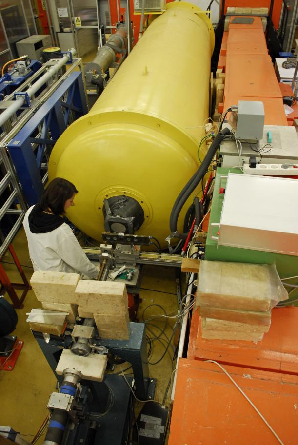Small Angle Neutron Scattering Diffractometer (SANS)
Budapest Neutron Centre
The Yellow Submarine SANS diffractometer covers a Q-range of 0.003 to 0.7 Å-1 allowing to probe structures at length scales from 5 Å to 1500 Å. It has a wide range of applications from studies of defects and precipitates in materials, alloy segregation, surfactant and colloid solutions, ferromagnetics, magnetic correlations, polymers, proteins and biological membranes alike. The instrument is installed on the curved neutron guide No.10/2, with a 40×40 mm2 cross-section, made of (m=1.5) supermirrors. The beam is monochromatized by a multidisc type velocity selector, (L. Rosta: Physica B 174 (1991) 562) the rotation speed can be tuned between 700 and 7000 rot/min (wavelengths between 3 and 12 Å). The width Δλ/λ of the transmitted wavelength distribution can be varied between 12% and 30% by changing the tilt angle between the selector axis and the direction of the neutron beam. The collimation distance is 5 m.

Contact: Laszlo Almasy
Technical specifications
| Beam Tube: | Cold neutron guide No. 10/2/1 |
| Monochromator: | Multidisk velocity selector |
| Detector: | 2D position sensitive, 64×64 cm2, filled with BF3 gas |
| Colimations: | 5 m |
| Flux at the Guide Exit: | 5 x 107 n/cm2/sec |
| Sample-to-Detector distance: | Continuously adjustable between 1 m and 5.5 m |
| Incident wavelength: | 3-12 A |
| Wavelength spread: | Adjustable between 12% – 30% |
Sample environment
In most experiments an automatic sample changer is used with 6 sample positions. Sample temperature can be controlled by a Julabo FP50 thermostat between 10 °C and 90 °C. For ambient temperatures a 10-position sample changer can be used. An electromagnet with a magnetic field up to 0.7 T at a pole distance of 25 mm can be mounted on the sample table, with a vertical automatic sample changer for 4 sample positions.
Detector
The scattered neutrons are detected by a 64 x 64 pixels (1cm x 1cm pixel size) two-dimensional position sensitive LETI (Grenoble, France) detector filled with BF3 gas.
Detailed information can be found on the instrument’s webpage.
-
20.02.2025
X-ray computed tomography (CT) TomoLab
-
23.01.2025
THz beamline TeraFERMI



